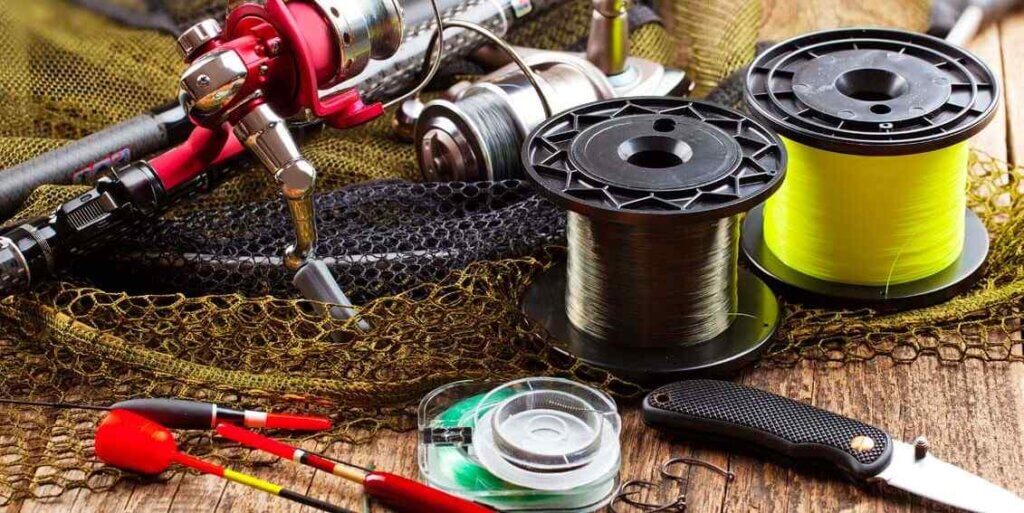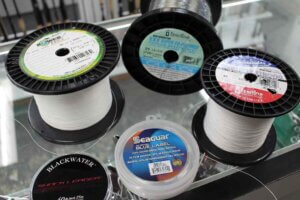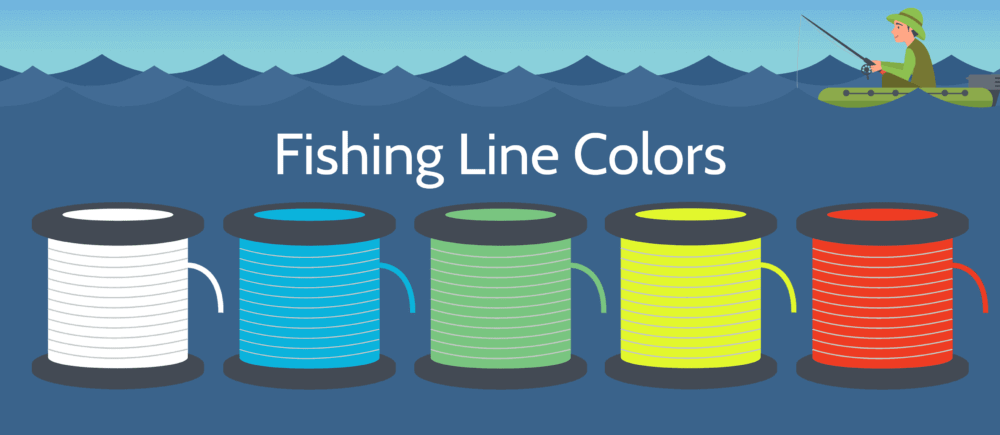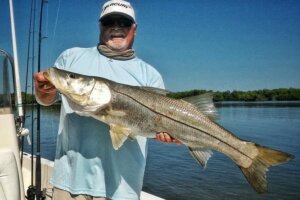
Are you in love with fishing? Are you always in a perpetual state of questioning about how to choose a fishing line? If yes, then you have come to a thorough and informative read.
Fishing lines are rods that are used for catching fish. It might appear like a straightforward tool, but it requires a lot of thinking to choose a perfect fishing line for oneself.
If you invest in the wrong kind, it might ruin your entire fishing experience.
This guide will help you end your search to the question of how to choose a fishing line.
Types of Fishing Lines
There are primarily three types of fishing lines; braided line, monofilament line, and fluorocarbon line.
Not every line is suited for everyone and every situation. Depending on your need and the type of area you choose to fish in, you can choose from the perfect fishing line.
Braided Fishing Line
A braided fish line is prepared with fibers that are woven together. This type of fishing line is not very stretchy, but its high sensitivity line.
The diameter of this line is much smaller than the other fishing line. However, the braided fish line’s breaking strength is similar to the monofilament line and fluorocarbon line.
Why choose a braided fishing line?

A significant advantage of choosing a braided fish line is the smaller diameter.
It offers a lot of benefits when it comes to fishing with this line. Smaller diameter allows you to cast it to longer distances.
The fishing reel allows you to load it up with an even smaller diameter fishing line if you use the braided one.
The braided fishing line is ideal for fishing with baits like plugs, crankbaits, or any other such bait that requires a long and accurate cast.
Another advantage point that comes with a smaller diameter fishing line is it can be used near the bottom of the eater body in the wind and current times.
Reaching such water levels where drag action gives you a chance to catch a fish with surety.
This would only be possible if the diameter is small; that is the case with the braided fish line.
If the diameter is more, a more substantial drag will get created near your fish line, and you will find it difficult to keep your bait in the right target zone.
Another great feature of the braided fishing line is that it does not stretch out a lot with ease.
This feature is increasing the sensitivity of this fish line. You will be able to sense a tap coming from any fish striking the bait with an apparent and sharp feel.
A lower stretch also helps you drive the hook to the fishes’ mouth quickly and more conveniently.
You can immediately set the hook-on strike when you feel the action happening near the bait.
Our Buying Guides:
- 5 Best Color Braided Lines for Surf Fishing Review
- 5 Best Line for Striper Fishing – Why Choose Them?
- Best Monofilament Fishing Line for Saltwater in 2021 [Top Pick]
- Best Monofilament Fishing Line for Spinning Reels in 2021
Why not choose a braided fish line?
Even though their small diameter provides innumerable advantage points, the braided fishing line is not suitable for all types of fishing.
The management of the braided fishing line is much more complicated than the monofilament line and fluorocarbon line.
The lesser diameter makes the line thinner, providing the line with absolute ease to tangle over itself very quickly.
This tangling can get so complicated that you might feel like banging your head while getting to untangle it.
It is also a bit difficult to make a knot with the braided fish line.
Therefore, the braided fish line is not the right choice for a beginner angler, as he/she might end up struggling with the knotting part itself.
The visibility of a braided fish line is relatively high for the fishes. It is clearer to spot in water as compared to the monofilament line and fluorocarbon line.
Many expert anglers, who prefer the braided fish line, will attach a clear line of the same length along with the braided line.
This exact line is called the leader, which helps to make the presentation better for this line.
The braided wish line also doesn’t prove to be very helpful in catching wary fish species in clear water.
For the same, the monofilament line and fluorocarbon line are preferred over the braided fish line.
Pros
- Smaller diameter
Cons
- Tangles easy
- Not meant for beginners.
Monofilament Fishing Lines
The monofilament fishing line uses a single fiber that is made with extruded nylon plastic. Mostly, the monofilament lines will be clear in appearance.
But you will easily find a colored or fluorescent variety too, as the manufacturer popularly produces it.
This line won’t cost you a lot and can be bought within your budget. It is cheaper than braided line and fluorocarbon line.
Why choose the monofilament line?

A great advantage with the monofilament line is that it is effortless to tie knots on this line. Due to this reason, it the most appropriate choice for beginners who are starting to learn fishing.
The use of monofilament is not just restricted to beginners. Many situations call for even the expert level anglers to switch to a monofilament fishing line.
The professional anglers who prefer fishing in high-speed water prefer going for the monofilament fishing line. The reason for the same is their ability to stretch.
The monofilament line can stretch out to a greater capacity than a braided line in waters that run strong.
This fishing line also has an excellent shock absorption capacity. So if a big fish strikes the fast-moving bait, this fishing line will be able to absorb shock more quickly and competently.
For a lot of anglers, the monofilament is a superior choice to the braided line. This is because the monofilament line makes a better choice for small bait casting reels.
It won’t dig into itself when the reel is spooled in a tensed state. This helps in avoiding the situation of backlash in the subsequent cast.
Why not choose the Monofilament line?
As mentioned earlier, the monofilament fishing line can stretch very well.
This great trait of this fishing line is also one of its lacking points. You will find it harder to feel the taps from the fish when it strikes the bait.
The diameter of the monofilament line is thicker than the braided line with a similar breaking strength.
This results in difficulty of casting to a longer distance. The larger diameter also makes it very difficult to use even light baits and jigs at the bottom of water or strong wind conditions.
Pros
- Easy to tie knots
- More shock absorption
Cons
- Less sensitive
Fluorocarbon Line
The fluorocarbon fishing lines are best suited for targeting the shyer species of fishes.
This is because these fishes will fear off from the presence of a braided or monofilament fishing line.
Just like a monofilament fishing line, the fluorocarbon line is also made from an extruded single strand. They are thicker than the braided lines with a similar breaking strength.
Why choose a fluorocarbon line?

The fluorocarbon fishing lines are the least visible lines to the fishes. The refractive index of these fishing lines is similar to water.
As a result, the light passes through the line with the lesser distortion, making it difficult for the fish to spot it.
The stretch on the monofilament line is lesser than any other line.
This provides for an improved ability to detect any tap or bites on the line and driving the hook straight into the mouth of the fish when it strikes.
The fluorocarbon lines offer remarkable durability than the monofilament line. They do not actively absorb water or get deteriorated by sunlight.
This line holds a unique ability to resist any abrasion condition, which you cannot see in any other line.
These lines also sink when put in water, making them an excellent choice for fishing light weigh baits near the water bottom.
It also provides ease when the water current does not create any drag on the fishing line.
The improved density of the fluorocarbon line makes it a fine choice for retrieving light baits like crankbaits.
It also helps in the casting of the spoon to greater depths. This is possible because it sinks quickly and does not keep floating like braid or monofilament lines.
Why not choose the fluorocarbon line?
The fluorocarbon fishing line density must seem like its advantage point, but it is not suitable for topwater plugs or water columns.
Such conditions require the bait to float, but the line will sink due to high density as soon as it hits the water.
As a result, you will be required to add floating lures for a better fishing experience.
The fluorocarbon line is quite stiff in comparison to other lines. It can get highly entangled if you push and spool a lot in the reel.
It also lacks the appropriate stretch. They are less stretchy as compared to monofilament and stretchier as compared to braided fishing line.
Thus, it does not provide extreme sensitivity towards the tapping or movement caused by the fish’s striking.
Pros
- Least visible
- Highly durable
Cons
- Require floating lures as it sinks down
- Not sensitive
Basics of Choosing a Fishing Line
It is not all about the type of line you choose. It is also about when you choose that type of line.
Every fishing situation is different, and it requires a different approach. It can be the line’s length, the strength of the line, the type of water, etc.

Choose the appropriate strength line.
You must be clear with the fishing your wish to engage in before you make the line choice. Every fishing line comes with a pound test strength.
This can range between one to 75 pounds. The pound test will depend on the type of fish you are looking to catch.
The best way to determine the same is to check the diameter of the line.
The narrower will be the line’s diameter; the lesser are the chances of putting off the fishes in the water.
Choosing the Line for Freshwater and Saltwater Fishing
The type of water you plan to fish in determines the type of fishing line you need to choose.
Saltwater and freshwater are different in density. So, you can certainly not go for the same fishing line for both situations.
Therefore, you need to make an appropriate choice as per your water requirements.
The density of freshwater is lesser than saltwater. Therefore, you will need a larger diameter to fish in freshwater.
This will help improve floatation in the water and help ease the fishing process.
Setting Up a Standard Fishing Line
Every fishing line has its strengths and weaknesses. Therefore, a reference fishing line is used to measure the required traits for better judgment.
A monofilament line is the most commonly used line for this purpose. The reason for the same is that it is pretty thin and strong.
It also makes the monofilament one of the most preferred fishing lines by both beginners and expert anglers.
The monofilament line has a narrow diameter. This reduces its intrusiveness in the water without affecting its exemplary measure on the pound test.
It is pretty durable as compared to other fish lines. But it is not immortal to breaking and from exposure to direct sunlight.
Therefore, you will be required to change the same every six months or in a year.
Fishing in Offshore Waters

Fishing offshore water has its requirement when it comes to fishing lines. Every line comes with different visibility, which is affected by the color of the line as well.
One of the most commonly used lines for offshore fishing is the High – viz line. The choice of color can vary from person to person.
It is always advisable to ask people around the fishing spot to know which is the most suited color for those waters.
If you cannot get your hands on a high-zig fishing line, you can opt for the metered or indicator line.
As the name suggests, these lines come with demarcated sections with a change in color at short lengths.
This variation of color allows you to set lures with ease, specifically at the desired measurements when you are fishing offshore.
Offshore fishing often means looking for a juicy or marlin. These fishes are strong and offer a lot of resistance when hooked.
Therefore, you need a good fishing line with a pound test and can handle a big fish’s pressure without breaking.
Experts anglers often prefer the monofilament fishing line. You can opt for a different one till it qualifies to handle a big fish without breaking.
Fishing in Inshore Waters

Inshore water does not require a narrow diameter fishing line. Therefore, you can choose a braided fish line for inshore fishing.
The waters inshore have low visibility and are murkier in comparison to offshore water.
A braided line will provide you with the ease of fishing without any inconvenience in such a situation.
As mentioned in the dedicated section to braided lines, they are made from woven fibers.
This feature gives them extraordinary strength along with durability and the ability to resist high levels of abrasion.
If you are not very comfortable using a braided line, you can also opt for a fluorocarbon fishing line.
It also offers great resistance to abrasion when dragged over rocks. It also has low visibility and will not stretch out abnormally, retaining its sensitivity.
Another thing to keep in mind while choosing a fishing line for inshore waters is that it should be low-viz. In general, lines of green, bronze, and brown are preferred for inshore fishing.
In areas that have a thick coverage of weed, the moss green line is preferred.
In areas with mud influence and dirt color water, the fishing line’s visibility decreases significantly, making it difficult for the fishes to notice.
A tip to remember with inshore water is that if it has a thick weed covering, it is always better to go for a braided line.
Fishes like Bass will find refuge between the weeds, and it becomes very hard for them because of the obstruction caused by the weed.
The braided line will cut through these weeds, and you can enjoy the same adventurous experience without any hassle.
Fishing in Clearwater

Clearwater in good weather is indeed a blessing for anglers. The best fishing line to opt for in such ideal conditions is the fluorocarbon line.
This is because the visibility of the fluorocarbon line is very low. It has a refractive index very close to that of water, making it go absolutely unnoticed in the water.
It will not get weak like the monofilament line in the water. It won’t even get stretched out, thus reducing the sensitivity of the same.
Using a clear line in clear waters is also a preferable option. A blue color fluorocarbon line makes an excellent choice for fishing on a clear sunny day.
The fish won’t judge the difference between the line and water, and you will spot it with ease above the water.
A gold high-viz filament line is often used when you wish to set multiple fishing lines.
In a condition where the sun is strong on reflection, it might get hard to keep track of all the lines.
A gold high – viz monofilament makes a perfect choice for such conditions.
However, it does come with a disadvantage. The visibility of this filament will be higher for the fishes under the water.
Final Thoughts
Fishing is an artsy outdoor activity that requires a lot of skill. Your skills are not used unless you put them into action with the right equipment and gear.
A fishing line is the only tool of the angler, along with bait. Therefore, it is necessary to invest quality time in research and understand your fishing line needs. Every fisher is different, and they follow their own rules.
The choice of fishing line will depend on a lot of factors. Your way of fishing, the type of fish you are looking for, and the water body of choice.
All these situations are given due consideration before making the right choice.
It is not important to choose only one fishing line every time you go out. You can alternate between the different types or choose according to the water body.
This detailed review will help you understand the requirements of different situations. This will assist you in making a sound decision with due consideration.
